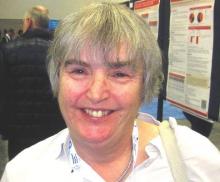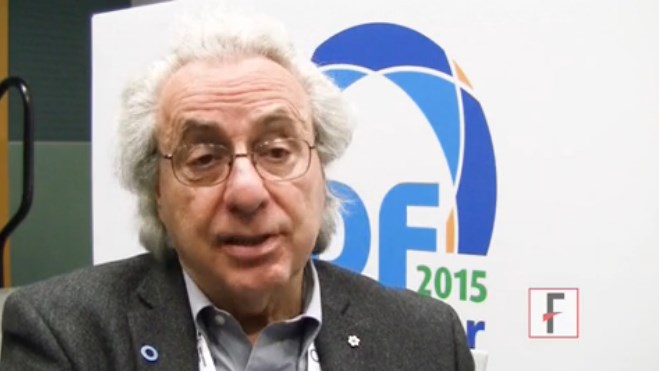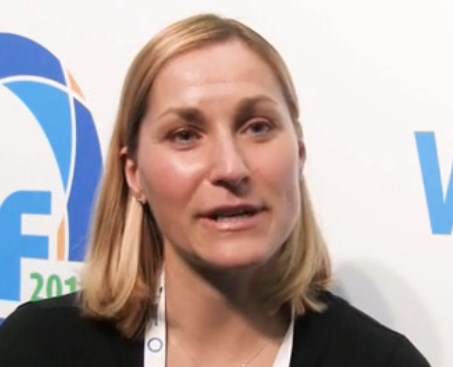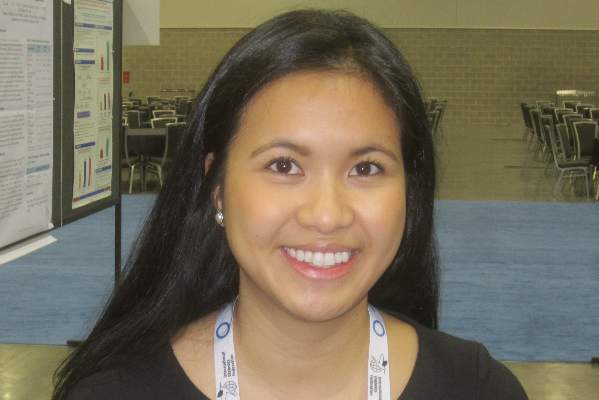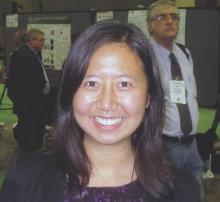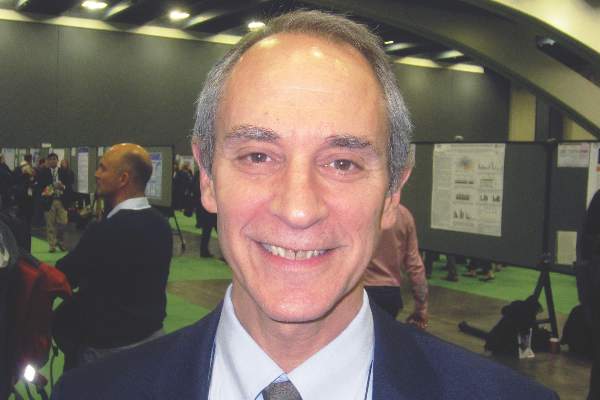User login
M. Alexander Otto began his reporting career early in 1999 covering the pharmaceutical industry for a national pharmacists' magazine and freelancing for the Washington Post and other newspapers. He then joined BNA, now part of Bloomberg News, covering health law and the protection of people and animals in medical research. Alex next worked for the McClatchy Company. Based on his work, Alex won a year-long Knight Science Journalism Fellowship to MIT in 2008-2009. He joined the company shortly thereafter. Alex has a newspaper journalism degree from Syracuse (N.Y.) University and a master's degree in medical science -- a physician assistant degree -- from George Washington University. Alex is based in Seattle.
WDC: Disease-modifying immunotherapy ‘the future of diabetes care’
VANCOUVER – Perhaps in the not-too-distant future, people at risk for type 1 diabetes will be screened for antibodies against beta cells, and, if two or more are present, started on immunotherapy to prevent beta cell destruction and clinical disease.
The vision is to treat “islet autoimmunity” as we do hypertension and other silent diseases to prevent problems down the road.
In the everyday medical world, that’s mostly science fiction for now – treatment starts when symptoms emerge – but researchers around the world are working hard to make it a reality, including Dr. Carla J. Greenbaum, director of the Diabetes Research Program at the Benaroya Research Institute in Seattle.
It’s known now that when babies have two or more antibodies against beta cells, about 11% per year will develop clinical diabetes, and all of them eventually. Adults with two or more antibodies will also develop diabetes, although at a slower rate than children.
“The take-home message is that type 1 diabetes starts when you have two antibodies. We need to change from symptom management to disease-modifying therapy, and that will require immunotherapy; it will be the future of diabetes care. Endocrinologists need to learn about immunotherapy,” Dr. Greenbaum said at the World Diabetes Congress.
So far, studies of four immunotherapies – teplizumab (Diabetes. 2013 Nov;62[11]:3766-74), rituximab (N Engl J Med. 2009 Nov 26;361[22]:2143-52), abatacept (Diabetes Care. 2014 Apr;37[4]:1069-75), and, most recently, alefacept (J Clin Invest. 2015 Aug 3;125[8]:3285-96) – have shown positive outcomes in preserving beta cell function after diagnosis of type 1. “The positive results are largely driven by children,” she said, suggesting that they might benefit most from a screen-and-treat approach to islet autoimmunity.
Teplizumab, oral insulin, and abatacept are now being tested in antibody-positive patients who haven’t developed symptoms. The trials aim to reduce the risk of clinical disease by 40%. If successful, treating 100 people with islet autoimmunity would prevent 14 from getting clinical type 1 diabetes, said Dr. Greenbaum, who is involved in the work.
A lot of questions need to be answered if the results pan out. Who should be screened, for instance, and how, and what immunotherapies should be used in different patient groups? What’s the right balance between risks and benefits?
There’s also a big question about how to “bring disease-modifying therapies to the clinic. As endocrinologists, we don’t use immunotherapies, but it’s important to recognize that millions of people for many decades have been using them safely to change the course of disease. We need to learn how to do this,” Dr. Greenbaum said.
“I often get people saying immunotherapy doesn’t really work, but that’s not true.” The effect sizes are small – maybe 20% – but it’s the same case in multiple sclerosis and rheumatoid arthritis. “The issue is if you have a weak joint, and you are 20% better, you feel it, but if beta cells are doing better, you might not notice,” she said.
Dr. Greenbaum disclosed research support from Novo Nordisk.
VANCOUVER – Perhaps in the not-too-distant future, people at risk for type 1 diabetes will be screened for antibodies against beta cells, and, if two or more are present, started on immunotherapy to prevent beta cell destruction and clinical disease.
The vision is to treat “islet autoimmunity” as we do hypertension and other silent diseases to prevent problems down the road.
In the everyday medical world, that’s mostly science fiction for now – treatment starts when symptoms emerge – but researchers around the world are working hard to make it a reality, including Dr. Carla J. Greenbaum, director of the Diabetes Research Program at the Benaroya Research Institute in Seattle.
It’s known now that when babies have two or more antibodies against beta cells, about 11% per year will develop clinical diabetes, and all of them eventually. Adults with two or more antibodies will also develop diabetes, although at a slower rate than children.
“The take-home message is that type 1 diabetes starts when you have two antibodies. We need to change from symptom management to disease-modifying therapy, and that will require immunotherapy; it will be the future of diabetes care. Endocrinologists need to learn about immunotherapy,” Dr. Greenbaum said at the World Diabetes Congress.
So far, studies of four immunotherapies – teplizumab (Diabetes. 2013 Nov;62[11]:3766-74), rituximab (N Engl J Med. 2009 Nov 26;361[22]:2143-52), abatacept (Diabetes Care. 2014 Apr;37[4]:1069-75), and, most recently, alefacept (J Clin Invest. 2015 Aug 3;125[8]:3285-96) – have shown positive outcomes in preserving beta cell function after diagnosis of type 1. “The positive results are largely driven by children,” she said, suggesting that they might benefit most from a screen-and-treat approach to islet autoimmunity.
Teplizumab, oral insulin, and abatacept are now being tested in antibody-positive patients who haven’t developed symptoms. The trials aim to reduce the risk of clinical disease by 40%. If successful, treating 100 people with islet autoimmunity would prevent 14 from getting clinical type 1 diabetes, said Dr. Greenbaum, who is involved in the work.
A lot of questions need to be answered if the results pan out. Who should be screened, for instance, and how, and what immunotherapies should be used in different patient groups? What’s the right balance between risks and benefits?
There’s also a big question about how to “bring disease-modifying therapies to the clinic. As endocrinologists, we don’t use immunotherapies, but it’s important to recognize that millions of people for many decades have been using them safely to change the course of disease. We need to learn how to do this,” Dr. Greenbaum said.
“I often get people saying immunotherapy doesn’t really work, but that’s not true.” The effect sizes are small – maybe 20% – but it’s the same case in multiple sclerosis and rheumatoid arthritis. “The issue is if you have a weak joint, and you are 20% better, you feel it, but if beta cells are doing better, you might not notice,” she said.
Dr. Greenbaum disclosed research support from Novo Nordisk.
VANCOUVER – Perhaps in the not-too-distant future, people at risk for type 1 diabetes will be screened for antibodies against beta cells, and, if two or more are present, started on immunotherapy to prevent beta cell destruction and clinical disease.
The vision is to treat “islet autoimmunity” as we do hypertension and other silent diseases to prevent problems down the road.
In the everyday medical world, that’s mostly science fiction for now – treatment starts when symptoms emerge – but researchers around the world are working hard to make it a reality, including Dr. Carla J. Greenbaum, director of the Diabetes Research Program at the Benaroya Research Institute in Seattle.
It’s known now that when babies have two or more antibodies against beta cells, about 11% per year will develop clinical diabetes, and all of them eventually. Adults with two or more antibodies will also develop diabetes, although at a slower rate than children.
“The take-home message is that type 1 diabetes starts when you have two antibodies. We need to change from symptom management to disease-modifying therapy, and that will require immunotherapy; it will be the future of diabetes care. Endocrinologists need to learn about immunotherapy,” Dr. Greenbaum said at the World Diabetes Congress.
So far, studies of four immunotherapies – teplizumab (Diabetes. 2013 Nov;62[11]:3766-74), rituximab (N Engl J Med. 2009 Nov 26;361[22]:2143-52), abatacept (Diabetes Care. 2014 Apr;37[4]:1069-75), and, most recently, alefacept (J Clin Invest. 2015 Aug 3;125[8]:3285-96) – have shown positive outcomes in preserving beta cell function after diagnosis of type 1. “The positive results are largely driven by children,” she said, suggesting that they might benefit most from a screen-and-treat approach to islet autoimmunity.
Teplizumab, oral insulin, and abatacept are now being tested in antibody-positive patients who haven’t developed symptoms. The trials aim to reduce the risk of clinical disease by 40%. If successful, treating 100 people with islet autoimmunity would prevent 14 from getting clinical type 1 diabetes, said Dr. Greenbaum, who is involved in the work.
A lot of questions need to be answered if the results pan out. Who should be screened, for instance, and how, and what immunotherapies should be used in different patient groups? What’s the right balance between risks and benefits?
There’s also a big question about how to “bring disease-modifying therapies to the clinic. As endocrinologists, we don’t use immunotherapies, but it’s important to recognize that millions of people for many decades have been using them safely to change the course of disease. We need to learn how to do this,” Dr. Greenbaum said.
“I often get people saying immunotherapy doesn’t really work, but that’s not true.” The effect sizes are small – maybe 20% – but it’s the same case in multiple sclerosis and rheumatoid arthritis. “The issue is if you have a weak joint, and you are 20% better, you feel it, but if beta cells are doing better, you might not notice,” she said.
Dr. Greenbaum disclosed research support from Novo Nordisk.
EXPERT ANALYSIS AT THE WORLD DIABETES CONGRESS
WDC: When diagnosed young, type 2 diabetes is more lethal than type 1
VANCOUVER – When diabetes is diagnosed from ages 15 to 30 years, type 2 patients are less likely than are type 1 patients to reach their 50th birthday, according to investigators from the University of Sydney.
Even just a few years after diagnosis, young type 2 patients have a worse cardiovascular profile and worse cardiovascular disease, which leads to an earlier death.
“We pay less attention to type 2 than type 1 in young people. They’re not as sick, and don’t develop [diabetic ketoacidosis] if they miss a treatment. But young type 2 is not a milder form of diabetes in young people, and its detrimental impact occurs early. Before we know what’s going on, patients are middle age, and it’s too late,” said investigator Maria Constantino, a Ph.D. candidate, nurse, and diabetes researcher and educator at the University of Sydney.
Screening for type 2 diabetes “should start at a young age in at-risk groups,” and diabetes cardiovascular risk criteria should be reconsidered so that younger type 2 patients aren’t overlooked because of their age. Current criteria likely “lead to delay in preventive treatment” in the young, she said.
The conclusions come from a review of diabetes patients treated since 1990 at the Royal Prince Alfred Hospital in Sydney (Diabetes Care. 2013 Dec; 36[12]:3863-9).
The investigators compared 354 type 2 patients with 470 type 1 patients diagnosed from age 15-30 years. By around the age of 40 years, 11% of the type 2 patients had died, vs. 6.8% with type 1 (hazard ratio, 2.0; 95% confidence interval, 1.2-3.2; P = .003). Strokes, coronary artery disease, and other macrovascular complications were also far more common in the type 2 group, and they had worse hypertension and dyslipidemia despite taking more drugs to combat both. Type 2 patients also had more albuminuria and neuropathy.
The differences occurred despite the fact that type 2 patients smoked less, had a slightly shorter duration of disease (11.6 vs. 14.7 years), and equivalent glycemic control with their type 1 counterparts, with a mean hemoglobin A1c of 8.1% in both groups. They were heavier, however, with a mean body mass index of 32.2 kg/m2 vs. 25.6 kg/m2 in type 1 patients.
In short, young-onset type 2 is a “more lethal phenotype of diabetes. We are not saying one type of diabetes is more important; we need to conquer both.” But in young type 2 patients, “we need to focus on more than just glycemic control.” Cardiovascular risk factors are “detectable early, and treatable,” Ms. Constantino said.
The investigators also compared their 354 young-onset type 2 patients with 1,062 patients diagnosed from age 40-50 years.
By the time they were about 50 years old, young-onset patients were 6.5 times more likely to have died than were their age-matched peers without diabetes in the general Australian population. The peak in excess mortality for those diagnosed in their 5th decade came at about age of 65 years, with a risk of death about 2.5 times higher than nondiabetic peers in the general population.
“The impact of type 2 is much higher the younger a person is. You can argue that in our enthusiasm to diagnose diabetes, we are casting our screening net wider and wider, and take pride in diagnosing many elderly patients with diabetes, but we should not lose sight of the fact that finding and treating an elderly person with diabetes has much less impact than finding and treating one in a young age group,” she said.
Ms. Constantino has no conflicts of interest.
VANCOUVER – When diabetes is diagnosed from ages 15 to 30 years, type 2 patients are less likely than are type 1 patients to reach their 50th birthday, according to investigators from the University of Sydney.
Even just a few years after diagnosis, young type 2 patients have a worse cardiovascular profile and worse cardiovascular disease, which leads to an earlier death.
“We pay less attention to type 2 than type 1 in young people. They’re not as sick, and don’t develop [diabetic ketoacidosis] if they miss a treatment. But young type 2 is not a milder form of diabetes in young people, and its detrimental impact occurs early. Before we know what’s going on, patients are middle age, and it’s too late,” said investigator Maria Constantino, a Ph.D. candidate, nurse, and diabetes researcher and educator at the University of Sydney.
Screening for type 2 diabetes “should start at a young age in at-risk groups,” and diabetes cardiovascular risk criteria should be reconsidered so that younger type 2 patients aren’t overlooked because of their age. Current criteria likely “lead to delay in preventive treatment” in the young, she said.
The conclusions come from a review of diabetes patients treated since 1990 at the Royal Prince Alfred Hospital in Sydney (Diabetes Care. 2013 Dec; 36[12]:3863-9).
The investigators compared 354 type 2 patients with 470 type 1 patients diagnosed from age 15-30 years. By around the age of 40 years, 11% of the type 2 patients had died, vs. 6.8% with type 1 (hazard ratio, 2.0; 95% confidence interval, 1.2-3.2; P = .003). Strokes, coronary artery disease, and other macrovascular complications were also far more common in the type 2 group, and they had worse hypertension and dyslipidemia despite taking more drugs to combat both. Type 2 patients also had more albuminuria and neuropathy.
The differences occurred despite the fact that type 2 patients smoked less, had a slightly shorter duration of disease (11.6 vs. 14.7 years), and equivalent glycemic control with their type 1 counterparts, with a mean hemoglobin A1c of 8.1% in both groups. They were heavier, however, with a mean body mass index of 32.2 kg/m2 vs. 25.6 kg/m2 in type 1 patients.
In short, young-onset type 2 is a “more lethal phenotype of diabetes. We are not saying one type of diabetes is more important; we need to conquer both.” But in young type 2 patients, “we need to focus on more than just glycemic control.” Cardiovascular risk factors are “detectable early, and treatable,” Ms. Constantino said.
The investigators also compared their 354 young-onset type 2 patients with 1,062 patients diagnosed from age 40-50 years.
By the time they were about 50 years old, young-onset patients were 6.5 times more likely to have died than were their age-matched peers without diabetes in the general Australian population. The peak in excess mortality for those diagnosed in their 5th decade came at about age of 65 years, with a risk of death about 2.5 times higher than nondiabetic peers in the general population.
“The impact of type 2 is much higher the younger a person is. You can argue that in our enthusiasm to diagnose diabetes, we are casting our screening net wider and wider, and take pride in diagnosing many elderly patients with diabetes, but we should not lose sight of the fact that finding and treating an elderly person with diabetes has much less impact than finding and treating one in a young age group,” she said.
Ms. Constantino has no conflicts of interest.
VANCOUVER – When diabetes is diagnosed from ages 15 to 30 years, type 2 patients are less likely than are type 1 patients to reach their 50th birthday, according to investigators from the University of Sydney.
Even just a few years after diagnosis, young type 2 patients have a worse cardiovascular profile and worse cardiovascular disease, which leads to an earlier death.
“We pay less attention to type 2 than type 1 in young people. They’re not as sick, and don’t develop [diabetic ketoacidosis] if they miss a treatment. But young type 2 is not a milder form of diabetes in young people, and its detrimental impact occurs early. Before we know what’s going on, patients are middle age, and it’s too late,” said investigator Maria Constantino, a Ph.D. candidate, nurse, and diabetes researcher and educator at the University of Sydney.
Screening for type 2 diabetes “should start at a young age in at-risk groups,” and diabetes cardiovascular risk criteria should be reconsidered so that younger type 2 patients aren’t overlooked because of their age. Current criteria likely “lead to delay in preventive treatment” in the young, she said.
The conclusions come from a review of diabetes patients treated since 1990 at the Royal Prince Alfred Hospital in Sydney (Diabetes Care. 2013 Dec; 36[12]:3863-9).
The investigators compared 354 type 2 patients with 470 type 1 patients diagnosed from age 15-30 years. By around the age of 40 years, 11% of the type 2 patients had died, vs. 6.8% with type 1 (hazard ratio, 2.0; 95% confidence interval, 1.2-3.2; P = .003). Strokes, coronary artery disease, and other macrovascular complications were also far more common in the type 2 group, and they had worse hypertension and dyslipidemia despite taking more drugs to combat both. Type 2 patients also had more albuminuria and neuropathy.
The differences occurred despite the fact that type 2 patients smoked less, had a slightly shorter duration of disease (11.6 vs. 14.7 years), and equivalent glycemic control with their type 1 counterparts, with a mean hemoglobin A1c of 8.1% in both groups. They were heavier, however, with a mean body mass index of 32.2 kg/m2 vs. 25.6 kg/m2 in type 1 patients.
In short, young-onset type 2 is a “more lethal phenotype of diabetes. We are not saying one type of diabetes is more important; we need to conquer both.” But in young type 2 patients, “we need to focus on more than just glycemic control.” Cardiovascular risk factors are “detectable early, and treatable,” Ms. Constantino said.
The investigators also compared their 354 young-onset type 2 patients with 1,062 patients diagnosed from age 40-50 years.
By the time they were about 50 years old, young-onset patients were 6.5 times more likely to have died than were their age-matched peers without diabetes in the general Australian population. The peak in excess mortality for those diagnosed in their 5th decade came at about age of 65 years, with a risk of death about 2.5 times higher than nondiabetic peers in the general population.
“The impact of type 2 is much higher the younger a person is. You can argue that in our enthusiasm to diagnose diabetes, we are casting our screening net wider and wider, and take pride in diagnosing many elderly patients with diabetes, but we should not lose sight of the fact that finding and treating an elderly person with diabetes has much less impact than finding and treating one in a young age group,” she said.
Ms. Constantino has no conflicts of interest.
AT THE WORLD DIABETES CONGRESS
Key clinical point: Screening for type 2 diabetes should start at a young age in at-risk groups, and diabetes cardiovascular risk criteria should be reconsidered so that younger type 2 patients aren’t overlooked because of their age.
Major finding: Among diabetics diagnosed at ages 15 to 30 years, 11% of type 2 patients, but only 6.8% of type 1 patients, were dead by age 40 years.
Data source: Review of diabetes patients treated since 1990 at the Royal Prince Alfred Hospital in Sydney.
Disclosures: The investigators have no disclosures.
WDC: Hemoglobin A1c screening catches diabetes in the hospital
Vancouver, B.C. – If a patient is admitted to the hospital with a plasma glucose at or above 140 mg/dL, it’s wise to check the hemoglobin A1c level to catch undiagnosed diabetes, according to British and Irish researchers.
“A combination of admission plasma glucose and hemoglobin A1c can be used to diagnose diabetes in acute medicine, provided care is taken when interpreting hemoglobin A1c results, as they can be affected by various medical conditions or certain drugs,” said investigator Dr. Sandip Ghosh, a diabetologist at Queen Elizabeth Hospital in Birmingham, England.
The conclusion comes from a review of 2,061 white inpatients at University Hospital Waterford (Ireland), 412 (20%) of whom were diagnosed with diabetes on admission or displayed symptoms and complications.
An admission plasma glucose level of 140.4 mg/dL correlated with a hemoglobin A1c of 6.5%, the threshold for diabetes diagnosis. If ordering a hemoglobin A1c is delayed until the plasma glucose reaches 200 mg/dL, “we are missing an awful lot of people with diabetes,” Dr. Ghosh said.
The linear correlation between admission plasma glucose and hemoglobin A1c levels wasn’t perfect (r2 = 0.63, P less than 0.001). The approach was highly specific but not very sensitive, possibly because of a hemoglobin A1c level that has been compromised by liver, renal, or other problems, said investigator Susan Manley, Ph.D., a biochemist at the Birmingham hospital.
The Joint British Diabetes Society is planning to release a nationwide guideline for diabetes screening at hospital admission, but the quickest and most cost-effective way to screen for diabetes is uncertain.
Dr. Ghosh and Dr. Manley are both involved with those efforts, and their study is an attempt to solve the problem. They and their colleagues are planning a prospective study of hemoglobin A1c screening approaches in a more racially diverse population.
Eventually, “we are going to use” these findings to help write the recommendations, but “we need to make sure emergency wards do make the measurements,” and that labs can handle an upsurge in hemoglobin A1c testing, Dr. Manley said.
For now, hemoglobin A1c is generally used to check glucose control in hospital patients already known to have diabetes, both in the United Kingdom and the United States. It’s attractive as a hospital screening tool, however, because it can help discriminate between patients who truly have diabetes and those who are hyperglycemic because of acute illness.
The study analyzed admission plasma glucose, hemoglobin A1c, oral glucose tolerance tests, and other measures in consecutive, short-term medical admissions to the Waterford hospital from 2005 to 2007. The researchers calculated that hemoglobin A1c screening would have identified about 40 more cases of diabetes.
The authors reported no conflicts of interest.
Vancouver, B.C. – If a patient is admitted to the hospital with a plasma glucose at or above 140 mg/dL, it’s wise to check the hemoglobin A1c level to catch undiagnosed diabetes, according to British and Irish researchers.
“A combination of admission plasma glucose and hemoglobin A1c can be used to diagnose diabetes in acute medicine, provided care is taken when interpreting hemoglobin A1c results, as they can be affected by various medical conditions or certain drugs,” said investigator Dr. Sandip Ghosh, a diabetologist at Queen Elizabeth Hospital in Birmingham, England.
The conclusion comes from a review of 2,061 white inpatients at University Hospital Waterford (Ireland), 412 (20%) of whom were diagnosed with diabetes on admission or displayed symptoms and complications.
An admission plasma glucose level of 140.4 mg/dL correlated with a hemoglobin A1c of 6.5%, the threshold for diabetes diagnosis. If ordering a hemoglobin A1c is delayed until the plasma glucose reaches 200 mg/dL, “we are missing an awful lot of people with diabetes,” Dr. Ghosh said.
The linear correlation between admission plasma glucose and hemoglobin A1c levels wasn’t perfect (r2 = 0.63, P less than 0.001). The approach was highly specific but not very sensitive, possibly because of a hemoglobin A1c level that has been compromised by liver, renal, or other problems, said investigator Susan Manley, Ph.D., a biochemist at the Birmingham hospital.
The Joint British Diabetes Society is planning to release a nationwide guideline for diabetes screening at hospital admission, but the quickest and most cost-effective way to screen for diabetes is uncertain.
Dr. Ghosh and Dr. Manley are both involved with those efforts, and their study is an attempt to solve the problem. They and their colleagues are planning a prospective study of hemoglobin A1c screening approaches in a more racially diverse population.
Eventually, “we are going to use” these findings to help write the recommendations, but “we need to make sure emergency wards do make the measurements,” and that labs can handle an upsurge in hemoglobin A1c testing, Dr. Manley said.
For now, hemoglobin A1c is generally used to check glucose control in hospital patients already known to have diabetes, both in the United Kingdom and the United States. It’s attractive as a hospital screening tool, however, because it can help discriminate between patients who truly have diabetes and those who are hyperglycemic because of acute illness.
The study analyzed admission plasma glucose, hemoglobin A1c, oral glucose tolerance tests, and other measures in consecutive, short-term medical admissions to the Waterford hospital from 2005 to 2007. The researchers calculated that hemoglobin A1c screening would have identified about 40 more cases of diabetes.
The authors reported no conflicts of interest.
Vancouver, B.C. – If a patient is admitted to the hospital with a plasma glucose at or above 140 mg/dL, it’s wise to check the hemoglobin A1c level to catch undiagnosed diabetes, according to British and Irish researchers.
“A combination of admission plasma glucose and hemoglobin A1c can be used to diagnose diabetes in acute medicine, provided care is taken when interpreting hemoglobin A1c results, as they can be affected by various medical conditions or certain drugs,” said investigator Dr. Sandip Ghosh, a diabetologist at Queen Elizabeth Hospital in Birmingham, England.
The conclusion comes from a review of 2,061 white inpatients at University Hospital Waterford (Ireland), 412 (20%) of whom were diagnosed with diabetes on admission or displayed symptoms and complications.
An admission plasma glucose level of 140.4 mg/dL correlated with a hemoglobin A1c of 6.5%, the threshold for diabetes diagnosis. If ordering a hemoglobin A1c is delayed until the plasma glucose reaches 200 mg/dL, “we are missing an awful lot of people with diabetes,” Dr. Ghosh said.
The linear correlation between admission plasma glucose and hemoglobin A1c levels wasn’t perfect (r2 = 0.63, P less than 0.001). The approach was highly specific but not very sensitive, possibly because of a hemoglobin A1c level that has been compromised by liver, renal, or other problems, said investigator Susan Manley, Ph.D., a biochemist at the Birmingham hospital.
The Joint British Diabetes Society is planning to release a nationwide guideline for diabetes screening at hospital admission, but the quickest and most cost-effective way to screen for diabetes is uncertain.
Dr. Ghosh and Dr. Manley are both involved with those efforts, and their study is an attempt to solve the problem. They and their colleagues are planning a prospective study of hemoglobin A1c screening approaches in a more racially diverse population.
Eventually, “we are going to use” these findings to help write the recommendations, but “we need to make sure emergency wards do make the measurements,” and that labs can handle an upsurge in hemoglobin A1c testing, Dr. Manley said.
For now, hemoglobin A1c is generally used to check glucose control in hospital patients already known to have diabetes, both in the United Kingdom and the United States. It’s attractive as a hospital screening tool, however, because it can help discriminate between patients who truly have diabetes and those who are hyperglycemic because of acute illness.
The study analyzed admission plasma glucose, hemoglobin A1c, oral glucose tolerance tests, and other measures in consecutive, short-term medical admissions to the Waterford hospital from 2005 to 2007. The researchers calculated that hemoglobin A1c screening would have identified about 40 more cases of diabetes.
The authors reported no conflicts of interest.
AT The WORLD DIABETES CONGRESS
Key clinical point: Check hemoglobin A1c level in patients with plasma glucose at or above 140 mg/dL to screen for diabetes.
Major finding: An admission plasma glucose of 140.4 mg/dL correlated with a hemoglobin A1c of 6.5% (r2 = 0.63, P less than .001).
Data source: A review of 2,061 white inpatients at University Hospital Waterford (Ireland).
Disclosures: The authors reported no conflicts of interest.
Lantus competitor Basaglar wins FDA approval
The Food and Drug Administration on Dec. 16 approved Lilly’s Basaglar (insulin glargine injection 100 unit/mL), a long-acting human insulin analog that will compete with Sanofi’s blockbuster Lantus.
Basaglar received tentative approval in 2014, but final approval was held up until the two companies settled a Sanofi lawsuit in September of 2015 that claimed patent infringement on the pen formulation of Lantus. Basaglar will now also have a pen option.
U.S. pricing information hasn’t been released, but in Europe, where Basaglar is already on the market, the pen formulation costs about 15% less than Lantus pens.
The approval was based, in part, on the FDA’s confidence in Lantus, which was approved in 2000. “The applicant demonstrated that Basaglar was sufficiently similar to Lantus to scientifically justify” approval, “and also provided Basaglar-specific data to establish the drug’s safety and efficacy for its approved uses. The Basaglar-specific data included two clinical trials enrolling 534 and 744 patients with type 1 and 2 diabetes mellitus, respectively,” the agency said in a statement.
Basaglar carries the same indications as Lantus to improve glycemic control in adults and children with type 1 diabetes and adults with type 2 diabetes. The agency said Basaglar is meant to be administered once daily at the same time every day. Lantus carries that dosing recommendation, but physicians have come to realize that its duration of action varies, and some now prefer a split dose with two daily injections, believing it provides tighter glycemic control.
“Long-acting insulin products like insulin glargine play an important role in the treatment of types 1 and 2 diabetes mellitus, and today’s approval is expected to expand the availability of treatment options for health care professionals and patients,” Dr. Jean-Marc Guettier, director of the FDA’s Division of Metabolism and Endocrinology Products, said in the agency statement.
Like any insulin, Basaglar can cause life-threatening hypoglycemia, and life-threatening allergic reactions, including anaphylaxis.
Also as with any insulin, the agency noted, Basaglar should not be used during episodes of hypoglycemia, and patients should be monitored more closely when there are “changes to insulin dosage, co-administration of other glucose-lowering medications, meal pattern, physical activity and in patients with renal impairment or hepatic impairment or hypoglycemia unawareness.”
Adverse reactions in trials were generally the same as with Lantus, and included hypoglycemia, allergic reactions, injection site reactions, injection site pitting, itching, rash, edema, and weight gain.
Although considered a Lantus biosimilar by some, the FDA noted that “Basaglar is not approved as a biosimilar product. No insulin glargine products are currently licensed under the Public Health Service Act, so there is no reference product for a proposed biosimilar product.”
The Food and Drug Administration on Dec. 16 approved Lilly’s Basaglar (insulin glargine injection 100 unit/mL), a long-acting human insulin analog that will compete with Sanofi’s blockbuster Lantus.
Basaglar received tentative approval in 2014, but final approval was held up until the two companies settled a Sanofi lawsuit in September of 2015 that claimed patent infringement on the pen formulation of Lantus. Basaglar will now also have a pen option.
U.S. pricing information hasn’t been released, but in Europe, where Basaglar is already on the market, the pen formulation costs about 15% less than Lantus pens.
The approval was based, in part, on the FDA’s confidence in Lantus, which was approved in 2000. “The applicant demonstrated that Basaglar was sufficiently similar to Lantus to scientifically justify” approval, “and also provided Basaglar-specific data to establish the drug’s safety and efficacy for its approved uses. The Basaglar-specific data included two clinical trials enrolling 534 and 744 patients with type 1 and 2 diabetes mellitus, respectively,” the agency said in a statement.
Basaglar carries the same indications as Lantus to improve glycemic control in adults and children with type 1 diabetes and adults with type 2 diabetes. The agency said Basaglar is meant to be administered once daily at the same time every day. Lantus carries that dosing recommendation, but physicians have come to realize that its duration of action varies, and some now prefer a split dose with two daily injections, believing it provides tighter glycemic control.
“Long-acting insulin products like insulin glargine play an important role in the treatment of types 1 and 2 diabetes mellitus, and today’s approval is expected to expand the availability of treatment options for health care professionals and patients,” Dr. Jean-Marc Guettier, director of the FDA’s Division of Metabolism and Endocrinology Products, said in the agency statement.
Like any insulin, Basaglar can cause life-threatening hypoglycemia, and life-threatening allergic reactions, including anaphylaxis.
Also as with any insulin, the agency noted, Basaglar should not be used during episodes of hypoglycemia, and patients should be monitored more closely when there are “changes to insulin dosage, co-administration of other glucose-lowering medications, meal pattern, physical activity and in patients with renal impairment or hepatic impairment or hypoglycemia unawareness.”
Adverse reactions in trials were generally the same as with Lantus, and included hypoglycemia, allergic reactions, injection site reactions, injection site pitting, itching, rash, edema, and weight gain.
Although considered a Lantus biosimilar by some, the FDA noted that “Basaglar is not approved as a biosimilar product. No insulin glargine products are currently licensed under the Public Health Service Act, so there is no reference product for a proposed biosimilar product.”
The Food and Drug Administration on Dec. 16 approved Lilly’s Basaglar (insulin glargine injection 100 unit/mL), a long-acting human insulin analog that will compete with Sanofi’s blockbuster Lantus.
Basaglar received tentative approval in 2014, but final approval was held up until the two companies settled a Sanofi lawsuit in September of 2015 that claimed patent infringement on the pen formulation of Lantus. Basaglar will now also have a pen option.
U.S. pricing information hasn’t been released, but in Europe, where Basaglar is already on the market, the pen formulation costs about 15% less than Lantus pens.
The approval was based, in part, on the FDA’s confidence in Lantus, which was approved in 2000. “The applicant demonstrated that Basaglar was sufficiently similar to Lantus to scientifically justify” approval, “and also provided Basaglar-specific data to establish the drug’s safety and efficacy for its approved uses. The Basaglar-specific data included two clinical trials enrolling 534 and 744 patients with type 1 and 2 diabetes mellitus, respectively,” the agency said in a statement.
Basaglar carries the same indications as Lantus to improve glycemic control in adults and children with type 1 diabetes and adults with type 2 diabetes. The agency said Basaglar is meant to be administered once daily at the same time every day. Lantus carries that dosing recommendation, but physicians have come to realize that its duration of action varies, and some now prefer a split dose with two daily injections, believing it provides tighter glycemic control.
“Long-acting insulin products like insulin glargine play an important role in the treatment of types 1 and 2 diabetes mellitus, and today’s approval is expected to expand the availability of treatment options for health care professionals and patients,” Dr. Jean-Marc Guettier, director of the FDA’s Division of Metabolism and Endocrinology Products, said in the agency statement.
Like any insulin, Basaglar can cause life-threatening hypoglycemia, and life-threatening allergic reactions, including anaphylaxis.
Also as with any insulin, the agency noted, Basaglar should not be used during episodes of hypoglycemia, and patients should be monitored more closely when there are “changes to insulin dosage, co-administration of other glucose-lowering medications, meal pattern, physical activity and in patients with renal impairment or hepatic impairment or hypoglycemia unawareness.”
Adverse reactions in trials were generally the same as with Lantus, and included hypoglycemia, allergic reactions, injection site reactions, injection site pitting, itching, rash, edema, and weight gain.
Although considered a Lantus biosimilar by some, the FDA noted that “Basaglar is not approved as a biosimilar product. No insulin glargine products are currently licensed under the Public Health Service Act, so there is no reference product for a proposed biosimilar product.”
Sugammadex OK’d to reverse neuromuscular blockade during surgery
The Food and Drug Administration approved on Dec. 15 Merck’s sugammadex (Bridion) injection to reverse the effects of neuromuscular blockade induced by rocuronium bromide and vecuronium bromide during surgery.
The safety and efficacy of sugammadex were evaluated in three phase III trials involving 456 participants; most recovered within 5 minutes. An FDA review of the drug found that there was less residual neuromuscular blockade with sugammadex compared to neostigmine, and a 4-minute time savings to extubation and operating room discharge.
“Bridion provides a new treatment option that may help patients recover sooner from medications used for intubation or ventilation during surgery. This drug enables medical personnel to reverse the effects of neuromuscular blocking drugs and restore spontaneous breathing after surgery,” Dr. Sharon Hertz, director of the FDA’s Division of Anesthesia, Analgesia, and Addiction Products, said in a statement.
Although approved in other countries, sugammadex has been in the FDA’s review process since 2007, previously rejected and held up by concerns over anaphylaxis and other issues.
Because of that, sugammadex was further evaluated in a randomized, double-blind, parallel-group, repeat-dose trial. Of the 299 participants treated with Bridion, one person had an anaphylactic reaction. “Clinicians should be aware of the possibility of a hypersensitivity reaction or anaphylaxis and should intervene as appropriate,” the agency said in its statement.
Cases of marked bradycardia, some of which have resulted in cardiac arrest, have also been observed within minutes after the administration of Bridion. Tachycardia and bradycardia have been associated with cases of anaphylaxis. “Patients should be closely monitored for hemodynamic changes during and after reversal of neuromuscular blockade, and treatment with anticholinergic agents, such as atropine, should be administered if clinically significant bradycardia is observed,” the agency said.
The most common side effects reported in trials were vomiting, hypotension, pain, headache, and nausea. “Doctors should also advise women using hormonal contraceptives that Bridion may temporarily reduce the contraceptive effect so they must use an alternate method of birth control for a period of time,” the agency said.
Rocuronium bromide and vecuronium bromide are used to paralyze the vocal cords for tracheal intubation, as well as to paralyze patients under general anesthesia and prevent spontaneous breathing during ventilation. Sugammadex is a new molecular entity of the gamma-cyclodextrin class, designed to bind rocuronium and vecuronium.
The Food and Drug Administration approved on Dec. 15 Merck’s sugammadex (Bridion) injection to reverse the effects of neuromuscular blockade induced by rocuronium bromide and vecuronium bromide during surgery.
The safety and efficacy of sugammadex were evaluated in three phase III trials involving 456 participants; most recovered within 5 minutes. An FDA review of the drug found that there was less residual neuromuscular blockade with sugammadex compared to neostigmine, and a 4-minute time savings to extubation and operating room discharge.
“Bridion provides a new treatment option that may help patients recover sooner from medications used for intubation or ventilation during surgery. This drug enables medical personnel to reverse the effects of neuromuscular blocking drugs and restore spontaneous breathing after surgery,” Dr. Sharon Hertz, director of the FDA’s Division of Anesthesia, Analgesia, and Addiction Products, said in a statement.
Although approved in other countries, sugammadex has been in the FDA’s review process since 2007, previously rejected and held up by concerns over anaphylaxis and other issues.
Because of that, sugammadex was further evaluated in a randomized, double-blind, parallel-group, repeat-dose trial. Of the 299 participants treated with Bridion, one person had an anaphylactic reaction. “Clinicians should be aware of the possibility of a hypersensitivity reaction or anaphylaxis and should intervene as appropriate,” the agency said in its statement.
Cases of marked bradycardia, some of which have resulted in cardiac arrest, have also been observed within minutes after the administration of Bridion. Tachycardia and bradycardia have been associated with cases of anaphylaxis. “Patients should be closely monitored for hemodynamic changes during and after reversal of neuromuscular blockade, and treatment with anticholinergic agents, such as atropine, should be administered if clinically significant bradycardia is observed,” the agency said.
The most common side effects reported in trials were vomiting, hypotension, pain, headache, and nausea. “Doctors should also advise women using hormonal contraceptives that Bridion may temporarily reduce the contraceptive effect so they must use an alternate method of birth control for a period of time,” the agency said.
Rocuronium bromide and vecuronium bromide are used to paralyze the vocal cords for tracheal intubation, as well as to paralyze patients under general anesthesia and prevent spontaneous breathing during ventilation. Sugammadex is a new molecular entity of the gamma-cyclodextrin class, designed to bind rocuronium and vecuronium.
The Food and Drug Administration approved on Dec. 15 Merck’s sugammadex (Bridion) injection to reverse the effects of neuromuscular blockade induced by rocuronium bromide and vecuronium bromide during surgery.
The safety and efficacy of sugammadex were evaluated in three phase III trials involving 456 participants; most recovered within 5 minutes. An FDA review of the drug found that there was less residual neuromuscular blockade with sugammadex compared to neostigmine, and a 4-minute time savings to extubation and operating room discharge.
“Bridion provides a new treatment option that may help patients recover sooner from medications used for intubation or ventilation during surgery. This drug enables medical personnel to reverse the effects of neuromuscular blocking drugs and restore spontaneous breathing after surgery,” Dr. Sharon Hertz, director of the FDA’s Division of Anesthesia, Analgesia, and Addiction Products, said in a statement.
Although approved in other countries, sugammadex has been in the FDA’s review process since 2007, previously rejected and held up by concerns over anaphylaxis and other issues.
Because of that, sugammadex was further evaluated in a randomized, double-blind, parallel-group, repeat-dose trial. Of the 299 participants treated with Bridion, one person had an anaphylactic reaction. “Clinicians should be aware of the possibility of a hypersensitivity reaction or anaphylaxis and should intervene as appropriate,” the agency said in its statement.
Cases of marked bradycardia, some of which have resulted in cardiac arrest, have also been observed within minutes after the administration of Bridion. Tachycardia and bradycardia have been associated with cases of anaphylaxis. “Patients should be closely monitored for hemodynamic changes during and after reversal of neuromuscular blockade, and treatment with anticholinergic agents, such as atropine, should be administered if clinically significant bradycardia is observed,” the agency said.
The most common side effects reported in trials were vomiting, hypotension, pain, headache, and nausea. “Doctors should also advise women using hormonal contraceptives that Bridion may temporarily reduce the contraceptive effect so they must use an alternate method of birth control for a period of time,” the agency said.
Rocuronium bromide and vecuronium bromide are used to paralyze the vocal cords for tracheal intubation, as well as to paralyze patients under general anesthesia and prevent spontaneous breathing during ventilation. Sugammadex is a new molecular entity of the gamma-cyclodextrin class, designed to bind rocuronium and vecuronium.
VIDEO: Top hits from 2015 World Diabetes Congress
VANCOUVER, B.C. – So far, just one of the newer diabetes drugs has been shown to cut cardiovascular risk in type 2 diabetes.
Dr. Bernard Zinman, chairman of the meeting’s program committee, explained which one it is, and also shared other highlights from this year’s World Diabetes Congress.
In an interview at the meeting, Dr. Zinman offered new insights on beta-cell preservation, diabetes prevention, pancreas imaging, the microbiome, and the best combination therapies for early intervention.
“Diabetes is a very complex disease,” said Dr. Zinman, also the director of the diabetes center at Mount Sinai Hospital in Toronto and a professor of medicine at the University of Toronto. “To imagine that there’s one therapy or one magic bullet” that’s going to take care of all the problems in diabetes, “is very naive.”
The video associated with this article is no longer available on this site. Please view all of our videos on the MDedge YouTube channel
VANCOUVER, B.C. – So far, just one of the newer diabetes drugs has been shown to cut cardiovascular risk in type 2 diabetes.
Dr. Bernard Zinman, chairman of the meeting’s program committee, explained which one it is, and also shared other highlights from this year’s World Diabetes Congress.
In an interview at the meeting, Dr. Zinman offered new insights on beta-cell preservation, diabetes prevention, pancreas imaging, the microbiome, and the best combination therapies for early intervention.
“Diabetes is a very complex disease,” said Dr. Zinman, also the director of the diabetes center at Mount Sinai Hospital in Toronto and a professor of medicine at the University of Toronto. “To imagine that there’s one therapy or one magic bullet” that’s going to take care of all the problems in diabetes, “is very naive.”
The video associated with this article is no longer available on this site. Please view all of our videos on the MDedge YouTube channel
VANCOUVER, B.C. – So far, just one of the newer diabetes drugs has been shown to cut cardiovascular risk in type 2 diabetes.
Dr. Bernard Zinman, chairman of the meeting’s program committee, explained which one it is, and also shared other highlights from this year’s World Diabetes Congress.
In an interview at the meeting, Dr. Zinman offered new insights on beta-cell preservation, diabetes prevention, pancreas imaging, the microbiome, and the best combination therapies for early intervention.
“Diabetes is a very complex disease,” said Dr. Zinman, also the director of the diabetes center at Mount Sinai Hospital in Toronto and a professor of medicine at the University of Toronto. “To imagine that there’s one therapy or one magic bullet” that’s going to take care of all the problems in diabetes, “is very naive.”
The video associated with this article is no longer available on this site. Please view all of our videos on the MDedge YouTube channel
EXPERT ANALYSIS FROM THE WORLD DIABETES CONGRESS
VIDEO: Early response predicts weight loss success with liraglutide
VANCOUVER, B.C. – If patients haven’t lost 5% or more of their body weight after 16 weeks on liraglutide at a daily dose of 3 mg, the drug’s not going to work for weight loss and should be stopped, according to findings from a study by Novo Nordisk, the maker of liraglutide, that was presented at the World Diabetes Congress.
The 3-mg dose is marketed for weight loss as Saxenda; the drug is also sold as Victoza for type 2 diabetes at a dose of up to 1.8 mg.
The findings come from a new analysis of Novo Nordisk’s SCALE study, which included diet and exercise along with liraglutide 3 mg. About two-thirds of obese and prediabetic patients, versus about a third of patients on placebo, responded early to the 3-mg dose, losing 5% or more of their weight by week 16. By week 56, they had a mean weight loss of 11.5%. About half of patients with type 2 diabetes were early responders; they lost a mean of 9.3% at week 56. Nonresponders lost about 3.7% of their body weight after 56 weeks. Rates of hepatobiliary disorders with liraglutide were highest in nondiabetic subjects, at 3.5% (N Engl J Med. 2015 Jul 2;373[1]:11-22).
In an interview at the meeting, investigator Dr. Matthias Blüher, an endocrinology professor at the University of Leipzig (Germany), explained how to make use of the findings.
The video associated with this article is no longer available on this site. Please view all of our videos on the MDedge YouTube channel
VANCOUVER, B.C. – If patients haven’t lost 5% or more of their body weight after 16 weeks on liraglutide at a daily dose of 3 mg, the drug’s not going to work for weight loss and should be stopped, according to findings from a study by Novo Nordisk, the maker of liraglutide, that was presented at the World Diabetes Congress.
The 3-mg dose is marketed for weight loss as Saxenda; the drug is also sold as Victoza for type 2 diabetes at a dose of up to 1.8 mg.
The findings come from a new analysis of Novo Nordisk’s SCALE study, which included diet and exercise along with liraglutide 3 mg. About two-thirds of obese and prediabetic patients, versus about a third of patients on placebo, responded early to the 3-mg dose, losing 5% or more of their weight by week 16. By week 56, they had a mean weight loss of 11.5%. About half of patients with type 2 diabetes were early responders; they lost a mean of 9.3% at week 56. Nonresponders lost about 3.7% of their body weight after 56 weeks. Rates of hepatobiliary disorders with liraglutide were highest in nondiabetic subjects, at 3.5% (N Engl J Med. 2015 Jul 2;373[1]:11-22).
In an interview at the meeting, investigator Dr. Matthias Blüher, an endocrinology professor at the University of Leipzig (Germany), explained how to make use of the findings.
The video associated with this article is no longer available on this site. Please view all of our videos on the MDedge YouTube channel
VANCOUVER, B.C. – If patients haven’t lost 5% or more of their body weight after 16 weeks on liraglutide at a daily dose of 3 mg, the drug’s not going to work for weight loss and should be stopped, according to findings from a study by Novo Nordisk, the maker of liraglutide, that was presented at the World Diabetes Congress.
The 3-mg dose is marketed for weight loss as Saxenda; the drug is also sold as Victoza for type 2 diabetes at a dose of up to 1.8 mg.
The findings come from a new analysis of Novo Nordisk’s SCALE study, which included diet and exercise along with liraglutide 3 mg. About two-thirds of obese and prediabetic patients, versus about a third of patients on placebo, responded early to the 3-mg dose, losing 5% or more of their weight by week 16. By week 56, they had a mean weight loss of 11.5%. About half of patients with type 2 diabetes were early responders; they lost a mean of 9.3% at week 56. Nonresponders lost about 3.7% of their body weight after 56 weeks. Rates of hepatobiliary disorders with liraglutide were highest in nondiabetic subjects, at 3.5% (N Engl J Med. 2015 Jul 2;373[1]:11-22).
In an interview at the meeting, investigator Dr. Matthias Blüher, an endocrinology professor at the University of Leipzig (Germany), explained how to make use of the findings.
The video associated with this article is no longer available on this site. Please view all of our videos on the MDedge YouTube channel
AT THE WORLD DIABETES CONGRESS
VIDEO: Another worry about energy drinks in kids
VANCOUVER – At least one of the commercially available energy drinks plays havoc with blood sugar and insulin levels in teen users, according to research from the University of Calgary (Alta.).
Ten teenage boys and ten girls were randomized to one regular “5-hour energy” drink, or, as a control, the decaffeinated version of the product, and then given an oral glucose tolerance test 40 minutes later.
In the second phase, the kids switched over to the drink they didn’t get in the first go-round, and the tolerance testing was repeated. Blood testing was done at baseline and throughout the study.
Investigator Jane Shearer, Ph.D., of the university’s department of biochemistry and molecular biology, explained the results, and why she’s worried about them, in an interview at the World Diabetes Congress.
Five-hour energy is a sugar-free 2-ounce drink containing about 200 mg of caffeine in its regular-strength formulation.
The findings raise another red flag about energy drinks in kids, especially if they are prone to diabetes. Dr. Shearer also shared her thoughts on what to do to address the issue.
The video associated with this article is no longer available on this site. Please view all of our videos on the MDedge YouTube channel
VANCOUVER – At least one of the commercially available energy drinks plays havoc with blood sugar and insulin levels in teen users, according to research from the University of Calgary (Alta.).
Ten teenage boys and ten girls were randomized to one regular “5-hour energy” drink, or, as a control, the decaffeinated version of the product, and then given an oral glucose tolerance test 40 minutes later.
In the second phase, the kids switched over to the drink they didn’t get in the first go-round, and the tolerance testing was repeated. Blood testing was done at baseline and throughout the study.
Investigator Jane Shearer, Ph.D., of the university’s department of biochemistry and molecular biology, explained the results, and why she’s worried about them, in an interview at the World Diabetes Congress.
Five-hour energy is a sugar-free 2-ounce drink containing about 200 mg of caffeine in its regular-strength formulation.
The findings raise another red flag about energy drinks in kids, especially if they are prone to diabetes. Dr. Shearer also shared her thoughts on what to do to address the issue.
The video associated with this article is no longer available on this site. Please view all of our videos on the MDedge YouTube channel
VANCOUVER – At least one of the commercially available energy drinks plays havoc with blood sugar and insulin levels in teen users, according to research from the University of Calgary (Alta.).
Ten teenage boys and ten girls were randomized to one regular “5-hour energy” drink, or, as a control, the decaffeinated version of the product, and then given an oral glucose tolerance test 40 minutes later.
In the second phase, the kids switched over to the drink they didn’t get in the first go-round, and the tolerance testing was repeated. Blood testing was done at baseline and throughout the study.
Investigator Jane Shearer, Ph.D., of the university’s department of biochemistry and molecular biology, explained the results, and why she’s worried about them, in an interview at the World Diabetes Congress.
Five-hour energy is a sugar-free 2-ounce drink containing about 200 mg of caffeine in its regular-strength formulation.
The findings raise another red flag about energy drinks in kids, especially if they are prone to diabetes. Dr. Shearer also shared her thoughts on what to do to address the issue.
The video associated with this article is no longer available on this site. Please view all of our videos on the MDedge YouTube channel
AT THE WORLD DIABETES CONGRESS
WDC: Transition to adult diabetes care is tough on kids
VANCOUVER, B.C. – Transitioning to adult diabetes care tripled hospital admissions for diabetic ketoacidosis in a Canadian study of 147 patients at Western University in London, Ont.
The number of diabetic ketoacidosis (DKA) admissions and emergency department visits for hypoglycemia or hyperglycemia increased from 65 during the 3 years before the subjects turned 18 to 101 during the 3 years afterward.
There were other problems, too. Mean hemoglobin A1c increased from 8.66 % to 8.89% after transition to adult care, and urine albumin creatinine ratio (ACR) testing decreased, with 47 patients (32%) tested at least once before transition, but 29 (20%) afterward.
“Some would say that these are teenagers, and they’ll are grow out of” it as they learn how to care for themselves as adults, “but I don’t think that’s good enough” because there’s an increased risk of acute complications. “The transition period is associated with worsening glycemic control and an increased risk of DKA admission. There is room for improved screening, as well. I think there is certainly a role for intervention,” said Dr. Jennifer Huynh, chief resident in internal medicine at Western University.
The differences in HbA1care big enough to worry about. “We know when A1c is high, even small increases or decreases” make a difference. Meanwhile, the increased risk of DKA (odds ratio, 3; 95% confidence interval, 1.19-7.5) is “very concerning,” she said at the World Diabetes Congress.
It’s been reported before that children with diabetes run into trouble when they move into adult care; the findings are a reminder of the issue, and help firm up the extent of the problem. The investigators were able to do a robust comparison of pre- and posttransition patients because the database at Western University links patients’ pediatric and adult records.
What often happens is that diabetes takes a backseat to school, work, relationships, and other pressures of emerging adulthood, and parents are no longer around to make sure kids take care of themselves. Given all that’s going on, it’s not surprising that the researchers also found there were 1,149 office visits in the 3 years before the subjects turned 18, but only 750 in the 3 years afterward.
All but three of the young adults in the study had type 1 diabetes, and just over half were women. At the baseline visit at 15 years of age, the median duration of diabetes was 5 years, mean weight was 66.4 kg, and the mean body mass index was 23.5 kg/m2. Forty-five subjects (31%) were on an insulin pump, 96 (65%) were on multiple daily injections, 3 (2%) were on premixed insulin, and 3 (2%) took oral agents.
Researchers at Western University and elsewhere are putting a lot of effort into figuring out how to improve the situation. Special transition clinics, support groups, and social media campaigns are just some of what’s being tried.
Investigators from Western University are finishing up a randomized trial to see if a transition coordinator helps. Patients were randomized to usual care or care overseen by the coordinator, a certified diabetes educator.
The coordinator stays in touch with the teenagers, sends them test results, reminds them of appointments for lab work and office visits, and, in general, serves as a sounding board, guide, and friend to help them manage the transition into adult care.
The hope is that the efforts will improves clinic attendance and glycemic control, among other things.
Western University is considering a survey of transition programs in Canada, to find out what works so “we can make some recommendations in terms of policy,” Dr. Huynh said.
The investigators have no conflicts of interest, and there was no industry funding for the work.
VANCOUVER, B.C. – Transitioning to adult diabetes care tripled hospital admissions for diabetic ketoacidosis in a Canadian study of 147 patients at Western University in London, Ont.
The number of diabetic ketoacidosis (DKA) admissions and emergency department visits for hypoglycemia or hyperglycemia increased from 65 during the 3 years before the subjects turned 18 to 101 during the 3 years afterward.
There were other problems, too. Mean hemoglobin A1c increased from 8.66 % to 8.89% after transition to adult care, and urine albumin creatinine ratio (ACR) testing decreased, with 47 patients (32%) tested at least once before transition, but 29 (20%) afterward.
“Some would say that these are teenagers, and they’ll are grow out of” it as they learn how to care for themselves as adults, “but I don’t think that’s good enough” because there’s an increased risk of acute complications. “The transition period is associated with worsening glycemic control and an increased risk of DKA admission. There is room for improved screening, as well. I think there is certainly a role for intervention,” said Dr. Jennifer Huynh, chief resident in internal medicine at Western University.
The differences in HbA1care big enough to worry about. “We know when A1c is high, even small increases or decreases” make a difference. Meanwhile, the increased risk of DKA (odds ratio, 3; 95% confidence interval, 1.19-7.5) is “very concerning,” she said at the World Diabetes Congress.
It’s been reported before that children with diabetes run into trouble when they move into adult care; the findings are a reminder of the issue, and help firm up the extent of the problem. The investigators were able to do a robust comparison of pre- and posttransition patients because the database at Western University links patients’ pediatric and adult records.
What often happens is that diabetes takes a backseat to school, work, relationships, and other pressures of emerging adulthood, and parents are no longer around to make sure kids take care of themselves. Given all that’s going on, it’s not surprising that the researchers also found there were 1,149 office visits in the 3 years before the subjects turned 18, but only 750 in the 3 years afterward.
All but three of the young adults in the study had type 1 diabetes, and just over half were women. At the baseline visit at 15 years of age, the median duration of diabetes was 5 years, mean weight was 66.4 kg, and the mean body mass index was 23.5 kg/m2. Forty-five subjects (31%) were on an insulin pump, 96 (65%) were on multiple daily injections, 3 (2%) were on premixed insulin, and 3 (2%) took oral agents.
Researchers at Western University and elsewhere are putting a lot of effort into figuring out how to improve the situation. Special transition clinics, support groups, and social media campaigns are just some of what’s being tried.
Investigators from Western University are finishing up a randomized trial to see if a transition coordinator helps. Patients were randomized to usual care or care overseen by the coordinator, a certified diabetes educator.
The coordinator stays in touch with the teenagers, sends them test results, reminds them of appointments for lab work and office visits, and, in general, serves as a sounding board, guide, and friend to help them manage the transition into adult care.
The hope is that the efforts will improves clinic attendance and glycemic control, among other things.
Western University is considering a survey of transition programs in Canada, to find out what works so “we can make some recommendations in terms of policy,” Dr. Huynh said.
The investigators have no conflicts of interest, and there was no industry funding for the work.
VANCOUVER, B.C. – Transitioning to adult diabetes care tripled hospital admissions for diabetic ketoacidosis in a Canadian study of 147 patients at Western University in London, Ont.
The number of diabetic ketoacidosis (DKA) admissions and emergency department visits for hypoglycemia or hyperglycemia increased from 65 during the 3 years before the subjects turned 18 to 101 during the 3 years afterward.
There were other problems, too. Mean hemoglobin A1c increased from 8.66 % to 8.89% after transition to adult care, and urine albumin creatinine ratio (ACR) testing decreased, with 47 patients (32%) tested at least once before transition, but 29 (20%) afterward.
“Some would say that these are teenagers, and they’ll are grow out of” it as they learn how to care for themselves as adults, “but I don’t think that’s good enough” because there’s an increased risk of acute complications. “The transition period is associated with worsening glycemic control and an increased risk of DKA admission. There is room for improved screening, as well. I think there is certainly a role for intervention,” said Dr. Jennifer Huynh, chief resident in internal medicine at Western University.
The differences in HbA1care big enough to worry about. “We know when A1c is high, even small increases or decreases” make a difference. Meanwhile, the increased risk of DKA (odds ratio, 3; 95% confidence interval, 1.19-7.5) is “very concerning,” she said at the World Diabetes Congress.
It’s been reported before that children with diabetes run into trouble when they move into adult care; the findings are a reminder of the issue, and help firm up the extent of the problem. The investigators were able to do a robust comparison of pre- and posttransition patients because the database at Western University links patients’ pediatric and adult records.
What often happens is that diabetes takes a backseat to school, work, relationships, and other pressures of emerging adulthood, and parents are no longer around to make sure kids take care of themselves. Given all that’s going on, it’s not surprising that the researchers also found there were 1,149 office visits in the 3 years before the subjects turned 18, but only 750 in the 3 years afterward.
All but three of the young adults in the study had type 1 diabetes, and just over half were women. At the baseline visit at 15 years of age, the median duration of diabetes was 5 years, mean weight was 66.4 kg, and the mean body mass index was 23.5 kg/m2. Forty-five subjects (31%) were on an insulin pump, 96 (65%) were on multiple daily injections, 3 (2%) were on premixed insulin, and 3 (2%) took oral agents.
Researchers at Western University and elsewhere are putting a lot of effort into figuring out how to improve the situation. Special transition clinics, support groups, and social media campaigns are just some of what’s being tried.
Investigators from Western University are finishing up a randomized trial to see if a transition coordinator helps. Patients were randomized to usual care or care overseen by the coordinator, a certified diabetes educator.
The coordinator stays in touch with the teenagers, sends them test results, reminds them of appointments for lab work and office visits, and, in general, serves as a sounding board, guide, and friend to help them manage the transition into adult care.
The hope is that the efforts will improves clinic attendance and glycemic control, among other things.
Western University is considering a survey of transition programs in Canada, to find out what works so “we can make some recommendations in terms of policy,” Dr. Huynh said.
The investigators have no conflicts of interest, and there was no industry funding for the work.
AT THE WORLD DIABETES CONGRESS
Key clinical point: Young people with diabetes need help transitioning to adult care.
Major finding: Transitioning to adult diabetes care tripled the risk of hospital admissions for diabetic ketoacidosis (OR, 3; 95% C.I., 1.19-7.5).
Data source: Population cohort study of 147 subjects.
Disclosures: The investigators have no conflicts of interest, and there was no industry funding for the work.
ACR: Don’t be fooled by contaminated synovial fluid
SAN FRANCISCO – Hold off on surgery in patients with presumed septic arthritis if they’re not otherwise too sick and their cultures don’t grow out a pathogenic organism within 48 hours.
The reason is because those patients are likely to have synovial fluid that was contaminated during collection, not a true joint infection.
The advice comes from investigators at Beth Israel Deaconess Medical Center, Boston, who compared 425 monoarticular septic arthritis cases with 25 cases that turned out to be false positives due to synovial fluid contamination; most of the false positives got antibiotics, and three (12%) had joint operations that they did not need.
“Rushing off to the operating room isn’t” always warranted. “You can suspect contamination if patients have milder disease manifestations and cultures grow late,” said investigator Dr. Robert H. Shmerling, clinical chief of Beth Israel’s division of rheumatology.
The findings help determine when – and when not – to be aggressive with patients who present with what looks to be septic arthritis. “No one’s ever really looked at this before,” he said at the annual meeting of the American College of Rheumatology.
“These are very different sorts of patients. Look at the full range of clinical characteristics and lab values, not just the synovial fluid tap. If contamination is suspected, you can wait until the cultures come back or possibly do serial taps before going to the operating room,” said coinvestigator Clara Zhu, a medical student at Boston University.
Patients with true joint infections had higher mean peripheral polymorphonuclear neutrophil percentages (78% vs. 68% in false positives) and synovial fluid polymorphonuclear cell percentages (88% vs. 74% in false positives). True cases also had substantially higher mean synovial fluid white blood cell counts (88,000 vs. 29,000).
Unlike true cases, contaminated synovial fluid took about 4 days to grow out a positive culture, and the most common organisms by far were coagulase-negative staphylococci, typically normal skin bacteria.
Patients with contaminated fluid also tended to be older (71 vs. 59 years), with fewer prior admissions. They were far less likely to have had recent joint procedures and histories of septic arthritis but were more likely to have synovial fluid crystals, as in gout. False positives also left the hospital sooner (7 vs. 11 days) and were less likely to be readmitted within 2 months. They were also less likely to present with fever (19% vs. 37%) but not significantly so.
This “study suggests that contaminated synovial fluid is found in up to 6% of patients with suspected septic arthritis and positive synovial fluid or synovial biopsy cultures. We recommend a conservative approach for patients with ... mild disease manifestations and no growth of pathogenic organisms within the first 48 hours,” the investigators concluded.
The authors have no disclosures, and there was no outside funding for the work.
SAN FRANCISCO – Hold off on surgery in patients with presumed septic arthritis if they’re not otherwise too sick and their cultures don’t grow out a pathogenic organism within 48 hours.
The reason is because those patients are likely to have synovial fluid that was contaminated during collection, not a true joint infection.
The advice comes from investigators at Beth Israel Deaconess Medical Center, Boston, who compared 425 monoarticular septic arthritis cases with 25 cases that turned out to be false positives due to synovial fluid contamination; most of the false positives got antibiotics, and three (12%) had joint operations that they did not need.
“Rushing off to the operating room isn’t” always warranted. “You can suspect contamination if patients have milder disease manifestations and cultures grow late,” said investigator Dr. Robert H. Shmerling, clinical chief of Beth Israel’s division of rheumatology.
The findings help determine when – and when not – to be aggressive with patients who present with what looks to be septic arthritis. “No one’s ever really looked at this before,” he said at the annual meeting of the American College of Rheumatology.
“These are very different sorts of patients. Look at the full range of clinical characteristics and lab values, not just the synovial fluid tap. If contamination is suspected, you can wait until the cultures come back or possibly do serial taps before going to the operating room,” said coinvestigator Clara Zhu, a medical student at Boston University.
Patients with true joint infections had higher mean peripheral polymorphonuclear neutrophil percentages (78% vs. 68% in false positives) and synovial fluid polymorphonuclear cell percentages (88% vs. 74% in false positives). True cases also had substantially higher mean synovial fluid white blood cell counts (88,000 vs. 29,000).
Unlike true cases, contaminated synovial fluid took about 4 days to grow out a positive culture, and the most common organisms by far were coagulase-negative staphylococci, typically normal skin bacteria.
Patients with contaminated fluid also tended to be older (71 vs. 59 years), with fewer prior admissions. They were far less likely to have had recent joint procedures and histories of septic arthritis but were more likely to have synovial fluid crystals, as in gout. False positives also left the hospital sooner (7 vs. 11 days) and were less likely to be readmitted within 2 months. They were also less likely to present with fever (19% vs. 37%) but not significantly so.
This “study suggests that contaminated synovial fluid is found in up to 6% of patients with suspected septic arthritis and positive synovial fluid or synovial biopsy cultures. We recommend a conservative approach for patients with ... mild disease manifestations and no growth of pathogenic organisms within the first 48 hours,” the investigators concluded.
The authors have no disclosures, and there was no outside funding for the work.
SAN FRANCISCO – Hold off on surgery in patients with presumed septic arthritis if they’re not otherwise too sick and their cultures don’t grow out a pathogenic organism within 48 hours.
The reason is because those patients are likely to have synovial fluid that was contaminated during collection, not a true joint infection.
The advice comes from investigators at Beth Israel Deaconess Medical Center, Boston, who compared 425 monoarticular septic arthritis cases with 25 cases that turned out to be false positives due to synovial fluid contamination; most of the false positives got antibiotics, and three (12%) had joint operations that they did not need.
“Rushing off to the operating room isn’t” always warranted. “You can suspect contamination if patients have milder disease manifestations and cultures grow late,” said investigator Dr. Robert H. Shmerling, clinical chief of Beth Israel’s division of rheumatology.
The findings help determine when – and when not – to be aggressive with patients who present with what looks to be septic arthritis. “No one’s ever really looked at this before,” he said at the annual meeting of the American College of Rheumatology.
“These are very different sorts of patients. Look at the full range of clinical characteristics and lab values, not just the synovial fluid tap. If contamination is suspected, you can wait until the cultures come back or possibly do serial taps before going to the operating room,” said coinvestigator Clara Zhu, a medical student at Boston University.
Patients with true joint infections had higher mean peripheral polymorphonuclear neutrophil percentages (78% vs. 68% in false positives) and synovial fluid polymorphonuclear cell percentages (88% vs. 74% in false positives). True cases also had substantially higher mean synovial fluid white blood cell counts (88,000 vs. 29,000).
Unlike true cases, contaminated synovial fluid took about 4 days to grow out a positive culture, and the most common organisms by far were coagulase-negative staphylococci, typically normal skin bacteria.
Patients with contaminated fluid also tended to be older (71 vs. 59 years), with fewer prior admissions. They were far less likely to have had recent joint procedures and histories of septic arthritis but were more likely to have synovial fluid crystals, as in gout. False positives also left the hospital sooner (7 vs. 11 days) and were less likely to be readmitted within 2 months. They were also less likely to present with fever (19% vs. 37%) but not significantly so.
This “study suggests that contaminated synovial fluid is found in up to 6% of patients with suspected septic arthritis and positive synovial fluid or synovial biopsy cultures. We recommend a conservative approach for patients with ... mild disease manifestations and no growth of pathogenic organisms within the first 48 hours,” the investigators concluded.
The authors have no disclosures, and there was no outside funding for the work.
AT THE ACR ANNUAL MEETING
Key clinical point: It’s probably not really septic arthritis if patients have mild disease manifestations and slow-growing synovial fluid cultures.
Major finding: True cases of septic arthritis had substantially higher mean synovial fluid white blood cell counts than did false-positive cases (88,000 vs. 29,000).
Data source: Review of 450 patients with presumed septic arthritis.
Disclosures: The authors have no disclosures, and there was no outside funding for the work.





